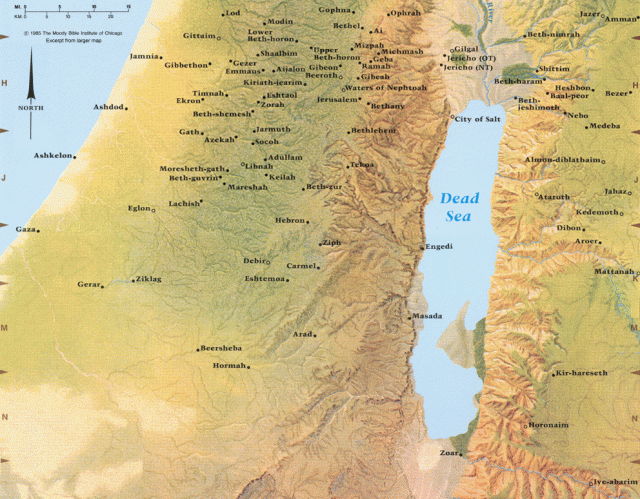Dead Sea
THE DEAD SEA IS a 390-square-mi (1,010-squarekm) salt lake located on the borders of PALESTINE, ISRAEL, and JORDAN. It is the lowest water point in the world, and its coast, at 1,292 ft below sea level (-395 m), is the lowest dry point on Earth. The lake is divided into two unequal parts by el-Lisan or “the Tongue,” which is a wide peninsula jutting from the lake's southeastern shore. The northern part is larger and deeper, reaching 1,300 ft (400 m) in depth. In contrast, the southern side reaches only 35 ft (11 m) and averages only 13 ft (4 m) in depth.
The Dead Sea formed when two plates of the Earth's crust began spreading apart, creating a low region, the Rift Valley system, where the crust is stretched quite thin. The Dead Sea is located in the region where the Earth's surface has sunk, and the lake's bottom is still sinking, as much as 13 in (33 cm) annually, an incredibly fast rate. In contrast, on the eastern and western sides of the lake, looming mountains range from 2,500 to 4,000 ft (762 to 1219 m) in height. The Jordan River is on the lake's north, and hills of solid salt (Jebel Usdum or Mount Sodom) rise up on its southern border. Lower than surrounding topography, the Dead Sea is fed over 6.5 million tons of fresh water by the Jordan River and smaller streams every single day. (It should be noted that large-scale Israeli and Jordanian irrigation projects along the Jordan River have been causing the depth of the Dead Sea to decrease over the past 50 years; pollution is a concern.)

Because the lake has no outlets and is completely LANDLOCKED, the only way that water leaves is through evaporation; because the Dead Sea is located in a hot area with low precipitation, water evaporates to the degree that the sea level seldom fluctuates, other than because of irrigation, and what is left behind is the salt. Twenty-seven percent of the Dead Sea consists of solid substances, including sodium chloride, magnesium chloride, calcium chloride, potassium chloride and magnesium bromide. Potash, bromine, gypsum, salt and other products are commercially extracted from these waters, which become saltier as depth increases. At about 130 ft (40 m), there are approximately 300 grams of salt per kilogram of water, which is about 10 times the saltiness of typical ocean water.
Once the depth is greater than 300 ft (91 m), there are 332 grams of salt per kilogram, which is a state of saturation and explains the piles of salt found at the lake's bottom. Due to this extreme saltiness, the Dead Sea supports no plant, animal, or fish life. If a fish swims from a stream into this lake, it is instantly killed and then preserved by the lake's mineral salts. The only types of life, then, existing in the Dead Sea are microbes and highly specialized algae; on occasion, a seabird is seen resting on the lake's surface.
Humans can swim in Dead Sea waters, but because of the extraordinarily high salt concentration and density of the water, the experience is more like floating. When a person exits the lake, the body is coated with white salts, just as the shores of the Dead Sea are covered with this substance, and the person's skin can become irritated. The salts can irritate the eyes, and the water, if swallowed, tastes revolting because of the chloride of magnesium. Chloride of calcium gives the water its oily appearance.
The name Dead Sea is used in the Old Testament, although other biblical names are also listed for this body of water, including the Salt Sea, East Sea, Sea of the Plain, and Sodomitish Sea; the ancient cities of Sodom and Gomorrah were located at the lake's southwestern coast. Yet another name is the Lake of Asphalt, given because of the quantities of bitumen that rise to the surface of this lake, and current inhabitants call this body of water the Sea of Lot.
This region is famous for the Dead Sea Scrolls found in 11 caves in nearby Qumran from 1947 to 1956. Literally thousands of Biblical fragments and ancient Jewish documents were found, which added greatly to the understanding of these religions. Today, the shores of the Dead Sea contain popular beaches, resorts, and spas.